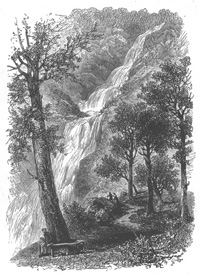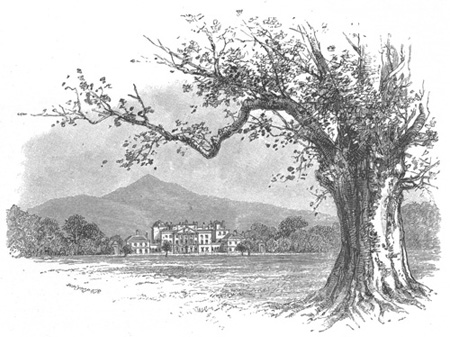Powerscourt Waterfall and House, County Wicklow - Irish Pictures (1888)
From Irish Pictures Drawn with Pen and Pencil (1888) by Richard Lovett
Chapter II: The Garden of Ireland … continued
« Previous Page | Start of Chapter | Book Contents | Next Page »
Near the head of the glen is the well-situated village of Enniskerry, and after a drive of a few miles through Lord Powerscourt's property, the Powerscourt Waterfall is reached. This again is very pretty, although occasionally visitors are disappointed, because somewhat overdrawn descriptions have raised their expectations too high. The effectiveness of the fall necessarily varies with the body of water coming over it. It is a fine fall and picturesquely situated; but he who goes fancying it is as picturesque as the Kilefos in the Naerodal, or as voluminous as the Mongefos in the Romsdal, will assuredly be disappointed, no matter how heavily it may have rained just prior to his visit.
A good pedestrian can make this the starting-point for a trip among the Wicklow Mountains, several of the highest peaks being in the neighbourhood, the highest mountain being Kippure, which just succeeds in overtopping the Donegal Errigal, and reaches an altitude of 2,475 feet. These do not seem very lofty in comparison with the Alpine giants, but they are quite high enough to afford healthy exercise and many splendid prospects.
A very fine drive is to continue on from the waterfall along Glencree to the Upper and Lower Lough Bray, 1,453 feet above the sea, nestling at the foot of Kippure, and then return by way of Enniskerry. Any one wishful to see a good specimen of a fine Irish country residence can gratify his taste by visiting Powerscourt House. It is more remarkable for extent and beauty of situation than for exceptional excellence in architecture, Powerscourt demesne covers about 26,000 acres. The first English owner was De la Poer, one of Strongbow's companions, The O'Byrnes and O'Tooles of Wicklow captured it in Henry VIII.'s time, and when retaken it was bestowed upon the Talbots. In 1556 the Kavanaghs acquired possession of it; and in 1608 James I. bestowed it upon Sir R. Wingfield, who was created Viscount Powerscourt in 1618.
« Previous Page | Start of Chapter | Book Contents | Next Page »


